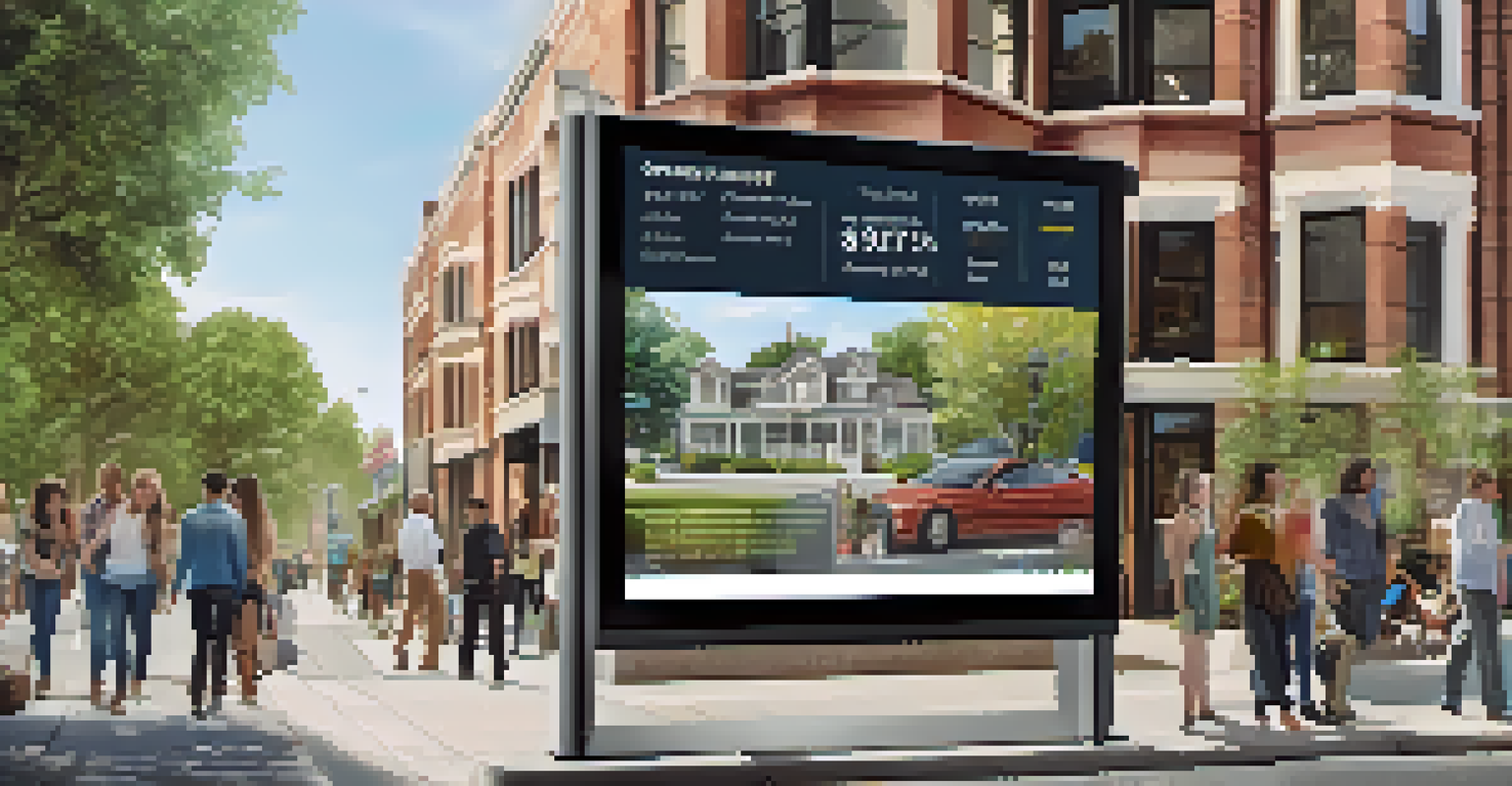Effective Use of Signage in Real Estate Marketing Strategies

The Importance of Signage in Real Estate Marketing
Signage plays a crucial role in real estate marketing by capturing attention and conveying important information. In a highly competitive market, a well-placed sign can be the difference between attracting a potential buyer or being overlooked. Think of signage as a first impression; it needs to be appealing and informative to spark interest.
Signage is a key element in real estate marketing; it’s the first impression that can make or break a sale.
Consider that most home buyers begin their search online, but physical signs are still vital in connecting the digital and real worlds. They guide potential buyers to properties, making them an essential tool for real estate agents. A strategically placed sign can even create a sense of urgency, especially if it's marked with 'For Sale' or 'Open House'.
Moreover, effective signage contributes to brand recognition. Consistent use of colors, fonts, and logos across signs helps build a recognizable brand. When potential clients see your signs, they should immediately think of your agency, fostering trust and familiarity.
Choosing the Right Type of Signage
When it comes to real estate signage, one size does not fit all. Different types of signs serve various purposes, from yard signs to directional signs and banners. For instance, a yard sign is perfect for showcasing a property, while directional signs help guide buyers during open houses.

It's essential to consider local regulations regarding sign types and placements. Some areas have restrictions on size, height, or even materials used. Understanding these regulations ensures that your signage is compliant and avoids any unnecessary fines.
Signage Captures Attention
Well-placed signage serves as a crucial first impression, drawing potential buyers and linking online searches to physical properties.
Additionally, think about the message you want to convey. A simple 'For Sale' may be effective, but adding details like price or unique property features can pique interest. The right type of signage delivers the right message to the right audience.
Designing Eye-Catching Signage
Design is everything when it comes to signage. An eye-catching design not only attracts attention but also conveys professionalism. Using bold colors, clear fonts, and high-quality images can make your signs stand out in a crowded marketplace.
Good signage is not just about visibility; it’s about creating a connection between the online and offline worlds.
Keep in mind the importance of simplicity; too much information can overwhelm potential buyers. A clean layout with essential details—like contact information and property highlights—ensures that your message is easily digestible. Think of your sign as a billboard; it needs to communicate quickly and effectively.
Moreover, consider the visibility of your signage from various distances. A well-designed sign should be legible from the street and not just from up close. Testing your sign in different lighting conditions can also help you assess its effectiveness.
Utilizing Technology for Signage
In today’s digital age, integrating technology into your signage can be a game-changer. Smart signs, which may include QR codes or NFC technology, allow potential buyers to access more information instantly. This tech-savvy approach can provide them with virtual tours or additional property details with a simple scan.
Moreover, digital signage offers flexibility in content. You can easily update listings, change prices, or promote open house events without the hassle of replacing physical signs. This adaptability ensures that your marketing remains current and relevant.
Design and Placement Matter
Effective signage relies on eye-catching design and strategic placement to ensure visibility and convey information clearly.
Using technology also extends to tracking engagement. By analyzing how many people interact with your digital signage, you can refine your marketing strategies. This data-driven approach helps you understand what works and what needs improvement.
Strategically Placing Your Signage
Placement is key when it comes to signage in real estate marketing. Signs should be positioned in high-traffic areas to maximize visibility. Whether it's a busy street or a popular neighborhood, placing your signage where potential buyers frequent can significantly boost exposure.
Consider the visibility from various angles; a sign that’s easy to see from the road but hidden behind trees won't be effective. Additionally, think about the flow of foot traffic during open houses. Placing directional signs strategically can guide visitors smoothly to the property entrance.
Lastly, seasonal changes can affect signage effectiveness. For example, during the fall, leaves may obscure signs placed in trees. Regularly checking and adjusting your signage placement ensures it remains effective year-round.
Integrating Signage with Overall Marketing Strategy
Signage should not stand alone; it’s most effective when integrated into your overall marketing strategy. Consider how your signage complements your online presence, social media campaigns, and print materials. A cohesive marketing strategy creates a unified brand experience for potential buyers.
For instance, using similar colors and designs on your website and signage reinforces brand identity. This consistency helps build trust and recognition among potential clients. When buyers see familiar branding across various platforms, they are more likely to remember you.
Integrate with Marketing Strategies
Signage should complement your overall marketing approach, enhancing brand recognition and encouraging digital engagement.
Additionally, leverage your signage to promote your online content. Including social media handles or website links on your signs encourages potential buyers to engage with your digital presence. This bridges the gap between physical and digital marketing, creating a more comprehensive approach.
Measuring the Success of Your Signage Efforts
To ensure your signage is effective, measuring its success is crucial. This can involve tracking inquiries generated from signage, monitoring open house attendance, or even conducting surveys to gauge public perception. Understanding what works helps refine future strategies.
Utilizing tools like Google Analytics for online engagement can provide insights into how well your signage drives traffic to your website. For physical signs, consider asking clients how they found out about the property during showings. This feedback can be invaluable.

Lastly, don’t shy away from making adjustments based on your findings. If a particular sign style or placement isn’t yielding results, be willing to experiment with new designs or locations. The real estate market is dynamic, and your signage strategy should be too.